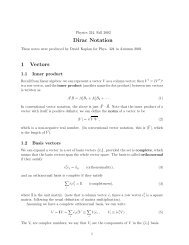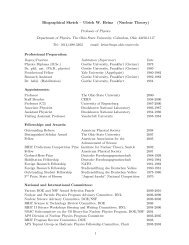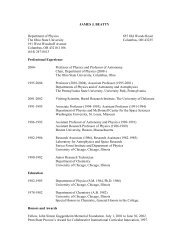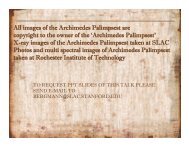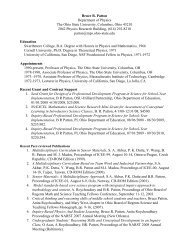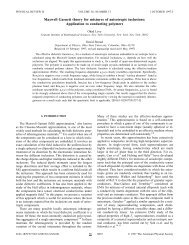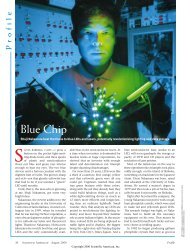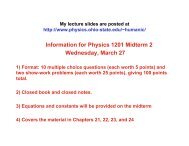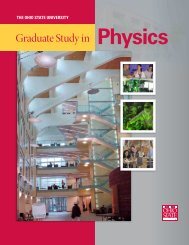Long Range and Short Range Magnetic Order in Orthorhombic ...
Long Range and Short Range Magnetic Order in Orthorhombic ...
Long Range and Short Range Magnetic Order in Orthorhombic ...
Create successful ePaper yourself
Turn your PDF publications into a flip-book with our unique Google optimized e-Paper software.
JOURNAL OF SOLID STATE CHEMISTRY 128, 209—214 (1997)<br />
ARTICLE NO. SC967189<br />
<strong>Long</strong> <strong>Range</strong> <strong>and</strong> <strong>Short</strong> <strong>Range</strong> <strong>Magnetic</strong> <strong>Order</strong><br />
<strong>in</strong> <strong>Orthorhombic</strong> LiMnO 2<br />
J. E. Greedan <strong>and</strong> N. P. Raju<br />
Brockhouse Institute for Materials, McMaster University, Hamilton L8S 4M1, Canada<br />
<strong>and</strong><br />
I. J. Davidson<br />
Institute for Chemical Process <strong>and</strong> Environmental Technology, NRC, Montreal Road, Ottawa, K1A 0R6, Canada<br />
Received June 14, 1996; <strong>in</strong> revised form October 9, 1996; accepted October 15, 1996<br />
The magnetic properties of orthorhombic LiMnO 2 have been<br />
<strong>in</strong>vestigated <strong>in</strong> detail for the first time. The susceptibility data<br />
show several features <strong>in</strong>clud<strong>in</strong>g a Curie–Weiss regime from 600<br />
to 800 K with p 1056(13) K <strong>and</strong> eff 4.82 B/Mn 3 ,<br />
a broad maximum at 360 K, <strong>and</strong> a field-cooled (FC), zero field<br />
cooled (ZFC) divergence below 100 K. The broad maximum<br />
<strong>in</strong>dicates two-dimensional rather than one-dimensional shortrange<br />
sp<strong>in</strong> correlations. A Néel temperature for a transition to<br />
three-dimensional long-range order is seen at 261.5 K from both<br />
neutron diffraction <strong>and</strong> the magnetic heat capacity behavior as<br />
determ<strong>in</strong>ed from the susceptibility data. The magnetic structure<br />
has been solved from neutron diffraction data <strong>and</strong> has a propagation<br />
vector of k"(1/21/21/2) <strong>and</strong> an ordered magnetic moment<br />
of 3.69(4) B/Mn 3 with a preferred direction parallel to the<br />
b axis. The neutron scatter<strong>in</strong>g data also provide evidence for<br />
two-dimensional short-range correlations above T c at 271 K <strong>in</strong><br />
the form of a feature with a Warren l<strong>in</strong>e shape. The long- <strong>and</strong><br />
short-range order are discussed <strong>in</strong> terms of the crystal structure<br />
which is of the ordered NaCl type distorted by the presence of the<br />
Jahn–Teller ion, Mn 3 . 1997 Academic Press<br />
1. INTRODUCTION<br />
<strong>Orthorhombic</strong> LiMnO has been known s<strong>in</strong>ce 1956 <strong>and</strong><br />
is one of a number of so-called ordered-NaCl structures (1).<br />
The detailed crystal structure was deduced first from powder<br />
<strong>and</strong> later from s<strong>in</strong>gle crystal X-ray diffraction data <strong>and</strong><br />
is described <strong>in</strong> Pmmn (2). This compound has received attention<br />
recently as a precursor for a cathode material <strong>in</strong> solid<br />
state lithium batteries, as it transforms to a defect sp<strong>in</strong>el<br />
structure upon electrochemical removal of Li (3—5). In spite<br />
of this <strong>in</strong>creased level of activity there have been no studies<br />
of basic physical properties such as magnetism.<br />
To whom correspondence should be addressed.<br />
209<br />
Certa<strong>in</strong> features of the crystal structure suggest that this<br />
material may have <strong>in</strong>terest<strong>in</strong>g magnetic properties. First, the<br />
local environment of the Mn—O octahedron is distorted<br />
significantly due to the presence of the Jahn—Teller ion<br />
Mn, 3d. There are two long axial Mn—O bonds of<br />
2.298(1) As directed along the b axis <strong>and</strong> two nearly equal<br />
equatorial pairs at 1.920(9) <strong>and</strong> 1.937(9) As . In typical ordered<br />
rock salt phases such as LiNiO one f<strong>in</strong>ds layers of<br />
nearly regular edge-shar<strong>in</strong>g octahedra which stack <strong>in</strong> a direction<br />
normal to the close-packed oxygen layers, result<strong>in</strong>g<br />
<strong>in</strong> rhombohedral symmetry. For LiMnO the oxygen sublattice<br />
is sufficiently distorted that the Mn—O <strong>and</strong> Li—O<br />
layers form a zigzag pattern with a stack<strong>in</strong>g direction nearly<br />
45° to that for the typical case (3).<br />
As a result of all of the above, the Mn sublattice has some<br />
unusual features as illustrated <strong>in</strong> Fig. 1. First, the hexagonal<br />
symmetry found <strong>in</strong> the rhombohedral, ordered NaCl phases<br />
is still present but the layers are distorted significantly <strong>and</strong><br />
folded, the fold angle be<strong>in</strong>g 111°. The basic edge-shar<strong>in</strong>g<br />
triangular motif is preserved but the triangles are distorted<br />
to isosceles with one edge at the a-axis distance of 2.806 As<br />
<strong>and</strong> the other two at 3.09 As with angles of 63°,63°, <strong>and</strong> 54°.<br />
Alternatively, one can also view the sublattice as comprised<br />
of l<strong>in</strong>ear cha<strong>in</strong>s of Mn atoms parallel to the a axis with<br />
a short Mn—Mn separation of 2.806 As . Two cha<strong>in</strong>s run<br />
through each cell at z"0.633 <strong>and</strong> 0.367 with an <strong>in</strong>tercha<strong>in</strong><br />
Mn—Mn separation of 3.09 As .<br />
The configuration of the Mn—O octahedra is shown <strong>in</strong><br />
Fig. 2. As the octahedra share edges, the <strong>in</strong>tra- <strong>and</strong> <strong>in</strong>tercha<strong>in</strong><br />
Mn—O—Mn angles, relevant for superexchange, are<br />
essentially identical at 93.3(2)° <strong>and</strong> 92.8(4)°, respectively. The<br />
zigzag Mn—O layers are connected via <strong>in</strong>terven<strong>in</strong>g Li—O<br />
layers with a closest <strong>in</strong>terlayer Mn—Mn distance of 5.00 As .<br />
Figure 2 is also useful as an aid to underst<strong>and</strong><strong>in</strong>g the<br />
orbital symmetry considerations which determ<strong>in</strong>e the<br />
0022-4596/97 $25.00<br />
Copyright 1997 by Academic Press<br />
All rights of reproduction <strong>in</strong> any form reserved.
210 GREEDAN, RAJU, AND DAVIDSON<br />
FIG. 1. The Mn sublattice <strong>in</strong> LiMnO .<br />
magnetic exchange pathways <strong>in</strong> this material. As a tetragonal<br />
elongation is <strong>in</strong>volved, the Mn configuration will<br />
be t d d . The <strong>in</strong>tracha<strong>in</strong> Mn—O—Mn 90° <strong>in</strong>teraction<br />
will <strong>in</strong>volve the empty d orbitals so this may be weak.<br />
The <strong>in</strong>tracha<strong>in</strong> Mn—Mn <strong>in</strong>teraction will occur via the halffilled<br />
t (d ) orbitals <strong>and</strong> will be strongly antiferromagnetic.<br />
The <strong>in</strong>tercha<strong>in</strong> exchange coupl<strong>in</strong>g is also by a 90°<br />
Mn—O—Mn pathway but the orbitals <strong>in</strong>volved are<br />
d —O—d <strong>and</strong> this will be relatively weaker <strong>and</strong> probably<br />
antiferromagnetic as discussed by Goodenough <strong>in</strong> comparison<br />
with other Mn materials show<strong>in</strong>g a static Jahn—Teller<br />
distortion (6). Thus, it is a good assumption that the strongest<br />
exchange <strong>in</strong>teraction <strong>in</strong> this material will be the antiferromagnetic<br />
Mn—Mn <strong>in</strong>teraction along the short a axis.<br />
FIG. 2. Edge-shar<strong>in</strong>g Mn—O octahedra <strong>in</strong> LiMnO .<br />
FIG. 3. Possible symmetry cancellation effect between antiferromagnetically<br />
correlated Mn cha<strong>in</strong>s <strong>in</strong> LiMnO .<br />
In addition, geometric effects may also be important. As<br />
already argued, the Mn sublattice can be regarded as a set of<br />
<strong>in</strong>terwoven a-axis cha<strong>in</strong>s with atom positions <strong>in</strong> adjacent<br />
cha<strong>in</strong>s displaced along c <strong>and</strong> also along a by (1/2 0 0) such<br />
that an atom <strong>in</strong> one cha<strong>in</strong> centers two sp<strong>in</strong>s <strong>in</strong> each adjacent<br />
cha<strong>in</strong>, as depicted <strong>in</strong> Fig. 3. If the <strong>in</strong>tracha<strong>in</strong> <strong>in</strong>teractions are<br />
strongly antiferromagnetic as expected, the <strong>in</strong>tercha<strong>in</strong> coupl<strong>in</strong>g<br />
may be subject to a symmetry cancellation as shown.<br />
Thus, at the highest temperatures the magnetic correlations<br />
would be one dimensional with cross-overs to two <strong>and</strong>,<br />
ultimately, three dimensionality as the temperature is<br />
lowered.<br />
2. EXPERIMENTAL<br />
(a) Sample Preparation LiMnO <br />
Samples of the orthorhombic form of LiMnO were prepared<br />
from Fisher Scientific Certified MnO <strong>and</strong> Aldrich<br />
99.997% pure Li CO . The powdered reagents were <strong>in</strong>timately<br />
mixed by gr<strong>in</strong>d<strong>in</strong>g <strong>and</strong> pelletiz<strong>in</strong>g. Then the pellets<br />
were loaded <strong>in</strong>to high purity alum<strong>in</strong>a crucibles <strong>and</strong> fired <strong>in</strong><br />
a horizontal tube furnace under a flow of argon gas. The<br />
mixture was first calc<strong>in</strong>ed at 600—650°C for several hours to<br />
remove the CO , <strong>and</strong> then baked at 800—1000°C for 1 to<br />
3 days. Generally, one or two more gr<strong>in</strong>d<strong>in</strong>gs <strong>and</strong> fir<strong>in</strong>gs<br />
were required to achieve a well crystallized product.
(b) <strong>Magnetic</strong> Measurements<br />
<strong>Magnetic</strong> susceptibility data were obta<strong>in</strong>ed us<strong>in</strong>g a Quantum<br />
Design SQUID magnetometer <strong>in</strong> the temperature<br />
range from 5 to 800 K us<strong>in</strong>g a 10 T applied field.<br />
(c) Neutron Diffraction<br />
Powder neutron diffraction data were collected at the<br />
McMaster Nuclear Reactor us<strong>in</strong>g a neutron wavelength of<br />
1.392 As <strong>and</strong> a position sensitive detector which has been<br />
described previously (7). A th<strong>in</strong>-walled vanadium can was<br />
used for room temperature experiments <strong>and</strong> at low temperatures<br />
an alum<strong>in</strong>um sample holder conta<strong>in</strong><strong>in</strong>g helium exchange<br />
gas <strong>and</strong> sealed with an <strong>in</strong>dium gasket was utilized.<br />
The sample was cooled by a closed-cycle refrigerator <strong>in</strong> the<br />
temperature range from 10 to 271 K. Data analysis was<br />
carried out us<strong>in</strong>g either DBWS PC9600 or FULLPROF<br />
(8, 9).<br />
3. RESULTS AND DISCUSSION<br />
(a) <strong>Magnetic</strong> Susceptibility<br />
Figure 4 displays susceptibility data for LiMnO over the<br />
<br />
range from 5 to 800 K. The most strik<strong>in</strong>g features are the<br />
maximum below 50 K, the field-cooled (FC), zero field<br />
cooled (ZFC) divergence below 100 K, <strong>and</strong> the broad maximum<br />
(<strong>in</strong>set) centered at about 360 K. The occurrence of the<br />
broad maximum is evidence for the presence of short-range<br />
magnetic correlations, consistent with speculations presented<br />
previously. In pr<strong>in</strong>ciple the dimensionality of the<br />
correlations can be assessed by fitt<strong>in</strong>g the data to models for<br />
FIG. 4. <strong>Magnetic</strong> susceptibility data for LiMnO from 5 to 800 K at an<br />
applied field of 10 T. The squares <strong>and</strong> triangles represent zero field<br />
cooled <strong>and</strong> field cooled conditions, respectively. The <strong>in</strong>set shows the broad,<br />
weak maximum at about 360 K.<br />
MAGNETIC ORDERING IN LiMnO <br />
one- <strong>and</strong> two-dimensional magnetic lattices. An attempt to<br />
fit to a one-dimensional model, S"2, failed, thus <strong>in</strong>dicat<strong>in</strong>g<br />
that the dom<strong>in</strong>ant correlations <strong>in</strong> this temperature regime<br />
are two-dimensional. This conclusion will be re<strong>in</strong>forced by<br />
the neutron scatter<strong>in</strong>g results <strong>in</strong> the follow<strong>in</strong>g section. Unfortunately,<br />
there exist no calculations for the two dimensional<br />
magnetic lattice pert<strong>in</strong>ent here, a puckered, distorted<br />
hexagonal net, so it is impossible to carry out a detailed<br />
fitt<strong>in</strong>g to extract the exchange constant. In any case there is<br />
no clear evidence for purely one-dimensional correlations <strong>in</strong><br />
the temperature regime <strong>in</strong>vestigated which <strong>in</strong>dicates that the<br />
<strong>in</strong>tracha<strong>in</strong> <strong>and</strong> <strong>in</strong>tercha<strong>in</strong> exchange <strong>in</strong>teractions must be<br />
comparable.<br />
In Fig. 5 the <strong>in</strong>verse susceptibility is plotted which shows<br />
an approach to the Curie—Weiss law at the highest temperatures.<br />
The extracted constants are C"2.90(2) emu<br />
K mol from which "4.82 /Mn can be derived<br />
compared to 4.90 for a S"2 free ion. A very large,<br />
negative "!1056(13) K is found which <strong>in</strong>dicates the<br />
presence of strong antiferromagnetic <strong>in</strong>teractions. The data<br />
also show a subtle <strong>in</strong>flection po<strong>in</strong>t near 250 K. The <strong>in</strong>set<br />
displays a plot of d(¹ )/d¹ <strong>in</strong> this temperature range. This<br />
function has been shown to be a measure of the magnetic<br />
contribution to the heat capacity (10) <strong>and</strong> the pronounced<br />
maximum at 260 K <strong>in</strong>dicates the presence of a magnetic<br />
phase transition.<br />
(b) Neutron Diffraction<br />
211<br />
A room temperature diffraction pattern was obta<strong>in</strong>ed <strong>and</strong><br />
the data were ref<strong>in</strong>ed by the Rietveld method primarily as<br />
a check on the sample purity <strong>and</strong> to compare with the<br />
FIG. 5. The <strong>in</strong>verse magnetic susceptibility of LiMnO . The <strong>in</strong>set<br />
shows the Fisher heat capacity (10) identify<strong>in</strong>g a transition at 261 K.
212 GREEDAN, RAJU, AND DAVIDSON<br />
FIG. 6. Low angle part of the neutron diffraction powder pattern for<br />
LiMnO at 11 K. Reflections of magnetic orig<strong>in</strong> are marked with an m. The<br />
solid l<strong>in</strong>e is a three-component Rietveld fit <strong>in</strong>clud<strong>in</strong>g the chemical structure,<br />
the Al sample can, <strong>and</strong> the magnetic structure of Fig. 7. The vertical tic<br />
marks locate the Bragg peak positions for the three respective components,<br />
the chemical structure, the sample can, <strong>and</strong> the magnetic structure (top to<br />
bottom).<br />
previous X-ray diffraction results. Neutron diffraction is<br />
often a more rigorous test of sample purity than X-ray<br />
diffraction as the neutron beam probes the entire sample<br />
volume. No additional phases were detected <strong>and</strong> the ref<strong>in</strong>ed<br />
unit cell parameters <strong>and</strong> atomic positions agreed very well<br />
with the results reported previously [2].<br />
Upon cool<strong>in</strong>g from room temperature to 11 K several<br />
strong reflections appeared, as shown <strong>in</strong> Fig. 6, which could<br />
be <strong>in</strong>dexed on a unit cell 2a2b2c with respect to the<br />
chemical cell which implies a magnetic propagation vector,<br />
k"(1/2 1/2 1/2). A model for the magnetic structure at 11 K<br />
was found readily by assum<strong>in</strong>g antiferromagnetic order<br />
with<strong>in</strong> each a-axis cha<strong>in</strong>, that the cha<strong>in</strong>s <strong>in</strong> each puckered<br />
layer couple antiferromagnetically, <strong>and</strong> that the <strong>in</strong>terplanar<br />
coupl<strong>in</strong>g is also antiferromagnetic. The best agreement was<br />
found for a coll<strong>in</strong>ear sp<strong>in</strong> model with an ordered moment of<br />
3.69(4) with a preferred sp<strong>in</strong> direction parallel to the<br />
b axis as depicted <strong>in</strong> Fig. 7. The fit <strong>in</strong> Fig. 6 is to a threecomponent<br />
model which <strong>in</strong>cludes the chemical structure,<br />
the alum<strong>in</strong>um sample can, <strong>and</strong> the magnetic structure of<br />
Fig. 7. The relevant ref<strong>in</strong>ement details are listed <strong>in</strong> Table 1.<br />
The temperature dependencies of the two most <strong>in</strong>tense<br />
magnetic reflections, (1/2 1/2 1/2) <strong>and</strong> (1/2 1/2 3/2), are<br />
shown <strong>in</strong> Fig. 8. First, note the clear <strong>in</strong>dication of a critical<br />
or Néel temperature, ¹ "260 K, confirm<strong>in</strong>g the susceptibility<br />
<strong>and</strong> magnetic heat capacity results of Figs. 4 <strong>and</strong> 5.<br />
A more precise value of ¹ can be obta<strong>in</strong>ed by fitt<strong>in</strong>g data<br />
near the order<strong>in</strong>g temperature to a power law of the type<br />
M"M [(¹ !¹ )/¹ ], where M is the sublattice magnet-<br />
FIG. 7. A (0 0 1) projection of the magnetic structure found for<br />
LiMnO .<br />
ization, ¹ is the critical temperature, <strong>and</strong> is the critical<br />
exponent (11). The results of such a fitt<strong>in</strong>g are shown <strong>in</strong><br />
Fig. 9 <strong>and</strong> the fitted parameters are ¹ "261.5(5) K <strong>and</strong><br />
"0.376(17). This later value is consistent with a threedimensional<br />
Heisenberg model which is reasonable for<br />
Mn (11).<br />
Also seen <strong>in</strong> Fig. 8 is the presence of an anomaly <strong>in</strong> the<br />
temperature dependence of the magnetic moment which sets<br />
<strong>in</strong> below 100 K, the temperature below which FC-ZFC<br />
irreversibilities are observed <strong>in</strong> the bulk susceptibility. Below<br />
100 K the <strong>in</strong>tensities of the strongest magnetic reflections,<br />
(1/2 1/2 1/2) at 2"18.16° <strong>and</strong> (1/2 1/2 3/2) at 26.94°,<br />
deviate <strong>in</strong> a positive <strong>and</strong> a negative sense, respectively, from<br />
the Brillou<strong>in</strong> function like dependence which perta<strong>in</strong>s at<br />
higher temperatures. This is due, most likely, to the onset of<br />
a small sublattice cant<strong>in</strong>g below 100 K. Thus, at low temperatures<br />
LiMnO is a weak ferromagnet. It was not possible<br />
to determ<strong>in</strong>e the cant<strong>in</strong>g angle from the available<br />
neutron data but it is likely to be small.<br />
One further issue concerns the characterization of the<br />
short-range magnetic order above ¹ . The powder pattern<br />
at 271 K, 10 K above ¹ (Fig. 10), shows that all of the<br />
magnetic Bragg peaks have disappeared but a pronounced,
TABLE 1<br />
Ref<strong>in</strong>ement Details for the <strong>Magnetic</strong> Structure of LiMnO 2<br />
at 12 K<br />
Chemical cell<br />
a 2.806(1) As<br />
b 4.550(2) As<br />
c 5.747(2) As<br />
<strong>Magnetic</strong> cell<br />
a 5.612(2) As<br />
b 9.100(4) As<br />
c 11.494(4) As<br />
Atomic positions (Pmmn)<br />
Li (2a) z"0.125<br />
Mn (2a) z"0.643<br />
O1 (2b) z"0.136<br />
O2 (2b) z"0.600<br />
<strong>Magnetic</strong> moment of Mn<br />
Moment direction<br />
3.69(4) <br />
<br />
[0 1 0]<br />
Overall thermal factor, B<br />
Agreement <strong>in</strong>dices<br />
0.500 (As )<br />
Overall<br />
Chemical structure<br />
Al sample holder<br />
<strong>Magnetic</strong> structure<br />
R "0.077<br />
<br />
R "0.023<br />
<br />
R "0.016<br />
<br />
R "0.005<br />
<br />
R "0.086<br />
<br />
Fixed at these values, ref<strong>in</strong>ement had no effect on the magnetic moment<br />
value.<br />
R "[w(½ !½ /c)]/w½ ,<br />
R "[(N!P)/½ ],<br />
<br />
R "<br />
(I !I )<br />
.<br />
I<br />
<br />
FIG. 8. Temperature dependence of the (1/2 1/2 1/2) <strong>and</strong> (1/2 1/2 3/2)<br />
magnetic Bragg peaks for LiMnO .<br />
MAGNETIC ORDERING IN LiMnO <br />
213<br />
FIG. 9. A power law fit to determ<strong>in</strong>e ¹ <strong>and</strong> the critical exponent for<br />
LiMnO .<br />
broad feature rema<strong>in</strong>s, centered at about 2"16°, which<br />
has a dist<strong>in</strong>ctly asymmetric shape with a relatively sharp rise<br />
at low angles followed by a more gradual decrease over<br />
several degrees to higher angles. This peak shape is of the<br />
Warren type which is a signal of two-dimensional correlations<br />
(12). The <strong>in</strong>sert <strong>in</strong> Fig. 10 shows a fit of this peak to the<br />
Warren function. A two-dimensional correlation length of<br />
36(1) As can be derived us<strong>in</strong>g methods described previously<br />
(13). Thus, it appears that at 271 K the Mn sp<strong>in</strong>s are correlated<br />
with<strong>in</strong> the puckered, distorted hexagonal layers which<br />
confirms the <strong>in</strong>terpretation of the susceptibility data given<br />
previously.<br />
FIG. 10. Low angle neutron diffraction pattern of LiMnO at 271 K<br />
show<strong>in</strong>g the broad, asymmetric Warren-type reflection at about 16° which<br />
represents magnetic short-range order. The <strong>in</strong>set shows a fit of this peak to<br />
the Warren function.
214 GREEDAN, RAJU, AND DAVIDSON<br />
FIG. 11. Comparison of neutron scatter<strong>in</strong>g at 271 <strong>and</strong> 200 K at the<br />
positions of the Warren peak <strong>and</strong> the (1/2 1/2 1/2) magnetic Bragg peak.<br />
F<strong>in</strong>ally, Fig. 11 shows that the two-dimensional correlations<br />
persist <strong>in</strong>to the ordered regime <strong>and</strong> that <strong>in</strong> fact the<br />
long-range order grows at the expense of the two-dimensional<br />
order. In this figure, data at 200 K, well below ¹ , <strong>and</strong><br />
271 K are compared after adjust<strong>in</strong>g the background of the<br />
two data sets. It is clearly seen that the Warren maximum<br />
lies to slightly lower angles than the (1/2 1/2 1/2) Bragg peak<br />
<strong>and</strong> that a vestige of the Warren feature is present at 200 K<br />
but with a much dim<strong>in</strong>ished amplitude.<br />
4. SUMMARY<br />
Although a relatively simple material, LiMnO exhibits<br />
complex magnetic behavior. Crystallographic distortions<br />
due to the presence of the Jahn—Teller ion, Mn, result <strong>in</strong><br />
a Mn sublattice which consists of folded, distorted hexagonal<br />
layers. This results <strong>in</strong> short-range magnetic correlations<br />
which are manifested <strong>in</strong> a broad susceptibility<br />
maximum at 350 K. Evidence from both susceptibility <strong>and</strong><br />
neutron scatter<strong>in</strong>g data characterize the short-range order<br />
as two dimensional. Below 261 K, long-range antiferromag-<br />
netic order is established with a magnetic structure hav<strong>in</strong>g<br />
a propagation vector k"(1/2 1/2 1/2). The details of<br />
the magnetic structure are consistent with expectations that<br />
the strongest exchange constra<strong>in</strong>ts are antiferromagnetic<br />
with<strong>in</strong> the a-axis cha<strong>in</strong>s <strong>and</strong> that the structure evolves by<br />
<strong>in</strong>tercha<strong>in</strong> coupl<strong>in</strong>g to form layers <strong>and</strong> f<strong>in</strong>ally, <strong>in</strong>terlayer<br />
coupl<strong>in</strong>g. The ordered moment is 3.65(2) /Mn <strong>and</strong> the<br />
preferred direction is along the b axis. Evidence for the onset<br />
of sp<strong>in</strong>-cant<strong>in</strong>g below 100 K is found from susceptibility <strong>and</strong><br />
neutron diffraction data.<br />
ACKNOWLEDGMENTS<br />
We thank the Natural Science <strong>and</strong> Eng<strong>in</strong>eer<strong>in</strong>g Research Council of<br />
Canada for f<strong>in</strong>ancial support <strong>and</strong> McMaster University for direct support<br />
of the McMaster Nuclear Reactor. C. V. Stager has provided access to the<br />
SQUID magnetometer.<br />
REFERENCES<br />
1. W. D. Johnston <strong>and</strong> R. R. Heikes, J. Am. Chem Soc. 78, 3255 (1956).<br />
2. G. Dittrich <strong>and</strong> R. Hoppe, Z. Anorg. Allg. Chem. 368, 262 (1969);<br />
R. Hoppe, G. Brachtel, <strong>and</strong> M. Jansen, Z. Anorg. Allg. Chem. 417,<br />
1 (1975).<br />
3. R. J. Gummow, D. C. Liles, <strong>and</strong> M. M. Thackeray, Mater. Res. Bull. 28,<br />
1249 (1993).<br />
4. T. Ohsuku, A. Ueda, <strong>and</strong> T. Hirai, Chem. Express 7, 193 (1992).<br />
5. I. J. Davidson, R. S. McMillan, J. J. Murray, <strong>and</strong> J. E. Greedan,<br />
J. Power Sources 54, 232 (1995).<br />
6. J. B. Goodenough, ‘‘Magnetism <strong>and</strong> the Chemical Bond.’’ Interscience,<br />
New York, 1963.<br />
7. J. N. Reimers, J. E. Greedan, <strong>and</strong> M. Sato, J. Solid State Chem. 72, 390<br />
(1988).<br />
8. D. B. Wiles <strong>and</strong> R. A. Young, J. Appl. Crystallogr. 14, 149 (1981).<br />
9. J. Rodriguez-Carvajal, ‘‘FULLPROF: A Program for Rietveld Ref<strong>in</strong>ement<br />
<strong>and</strong> Pattern Match<strong>in</strong>g Analysis’’ Abstracts of the Satellite Meet<strong>in</strong>g<br />
on Powder Diffraction of the XV Congress of the I.U.C. p. 27<br />
Toulouse, France, 1990.<br />
10. M. E. Fisher, Philos. Mag. 17, 1731 (1962).<br />
11. M. F. Coll<strong>in</strong>s, ‘‘<strong>Magnetic</strong> Critical Scatter<strong>in</strong>g,’’ pp. 12—15. Oxford Univ.<br />
Press, London, 1989.<br />
12. B. E. Warren, Phys. Rev. 59, 693 (1941).<br />
13. J. E. Greedan, M. Bier<strong>in</strong>ger, J. F. Britten, D. M. Giaqu<strong>in</strong>ta, <strong>and</strong><br />
H.-C zur Loye, J. Solid State Chem. 116, 118 (1995).




